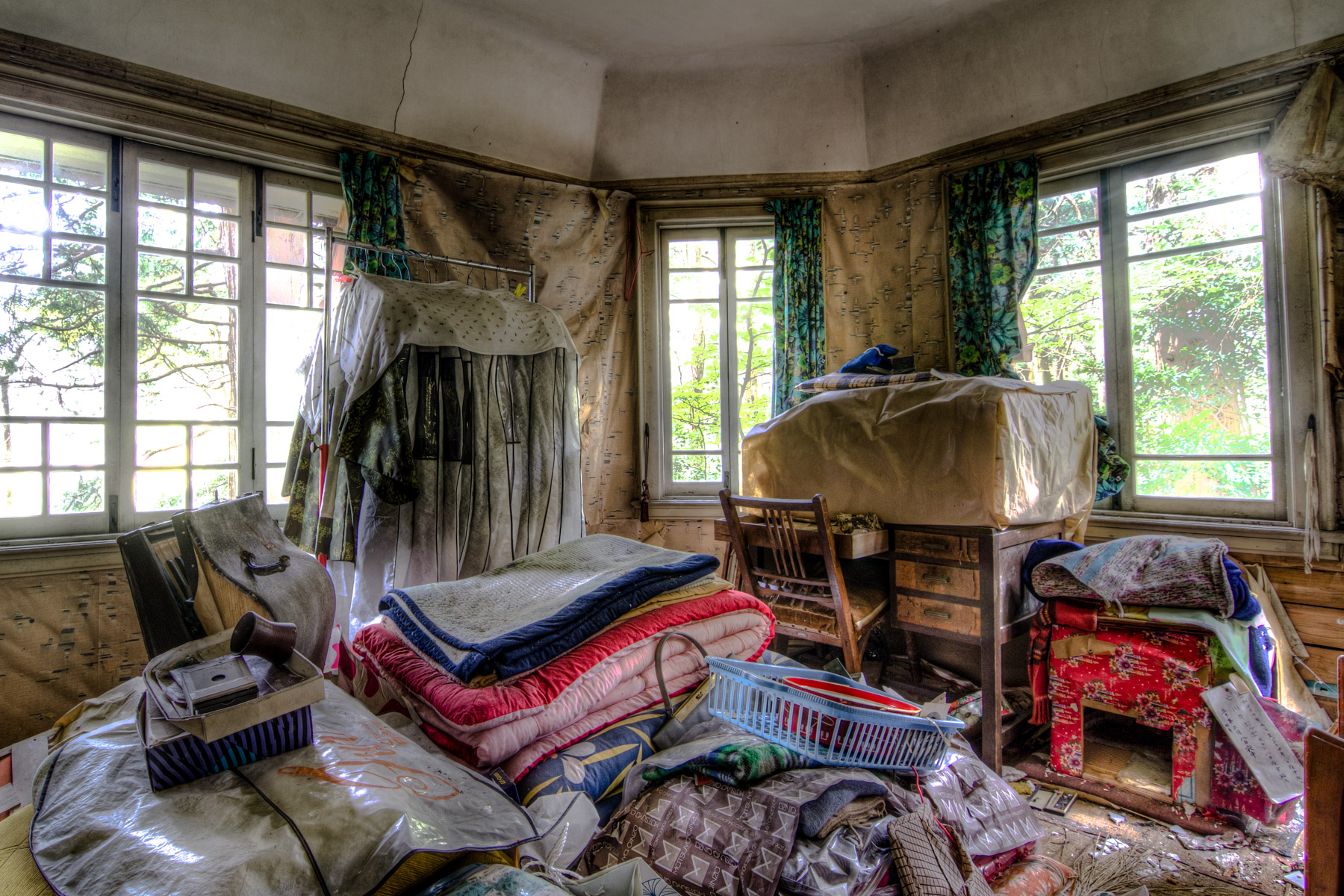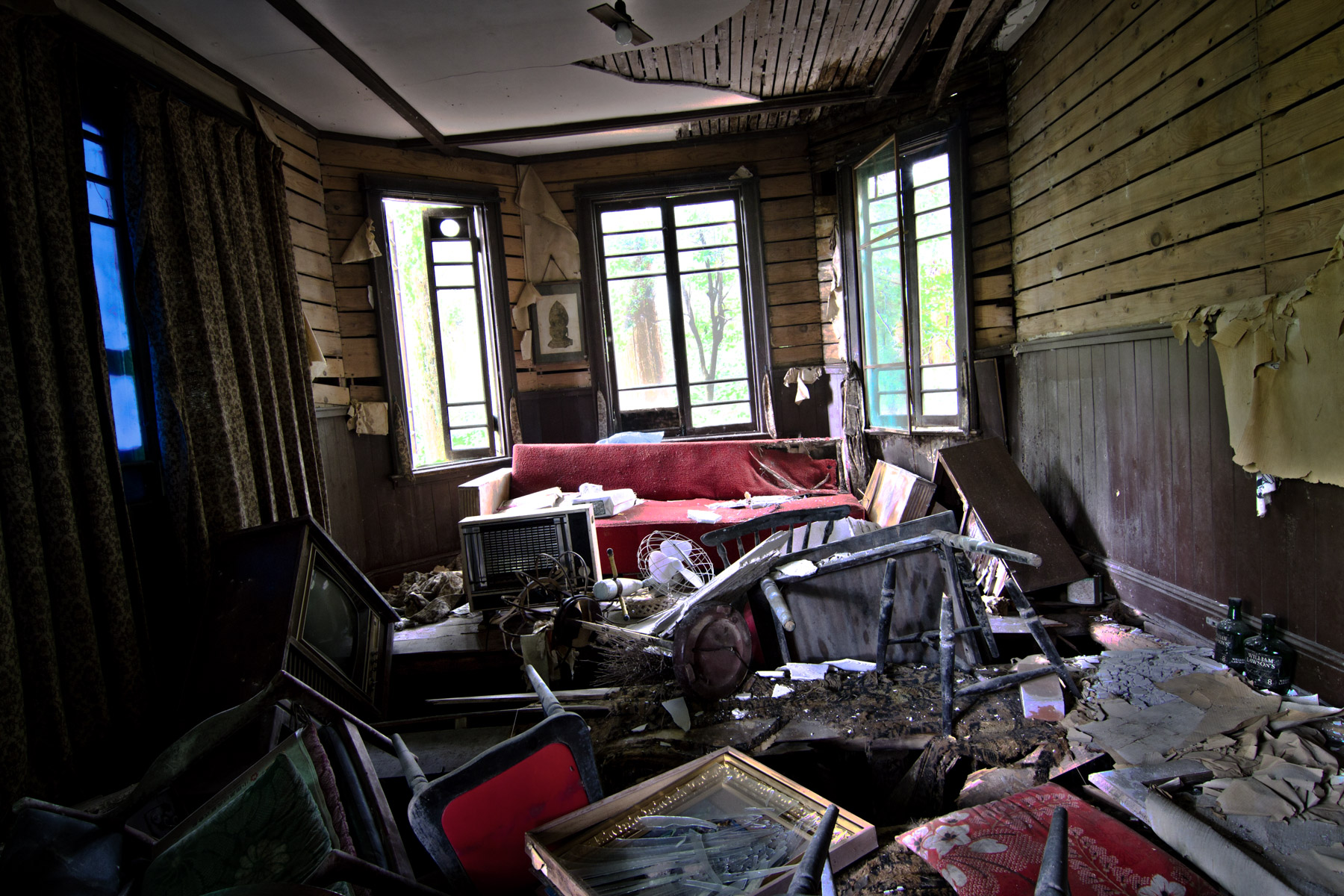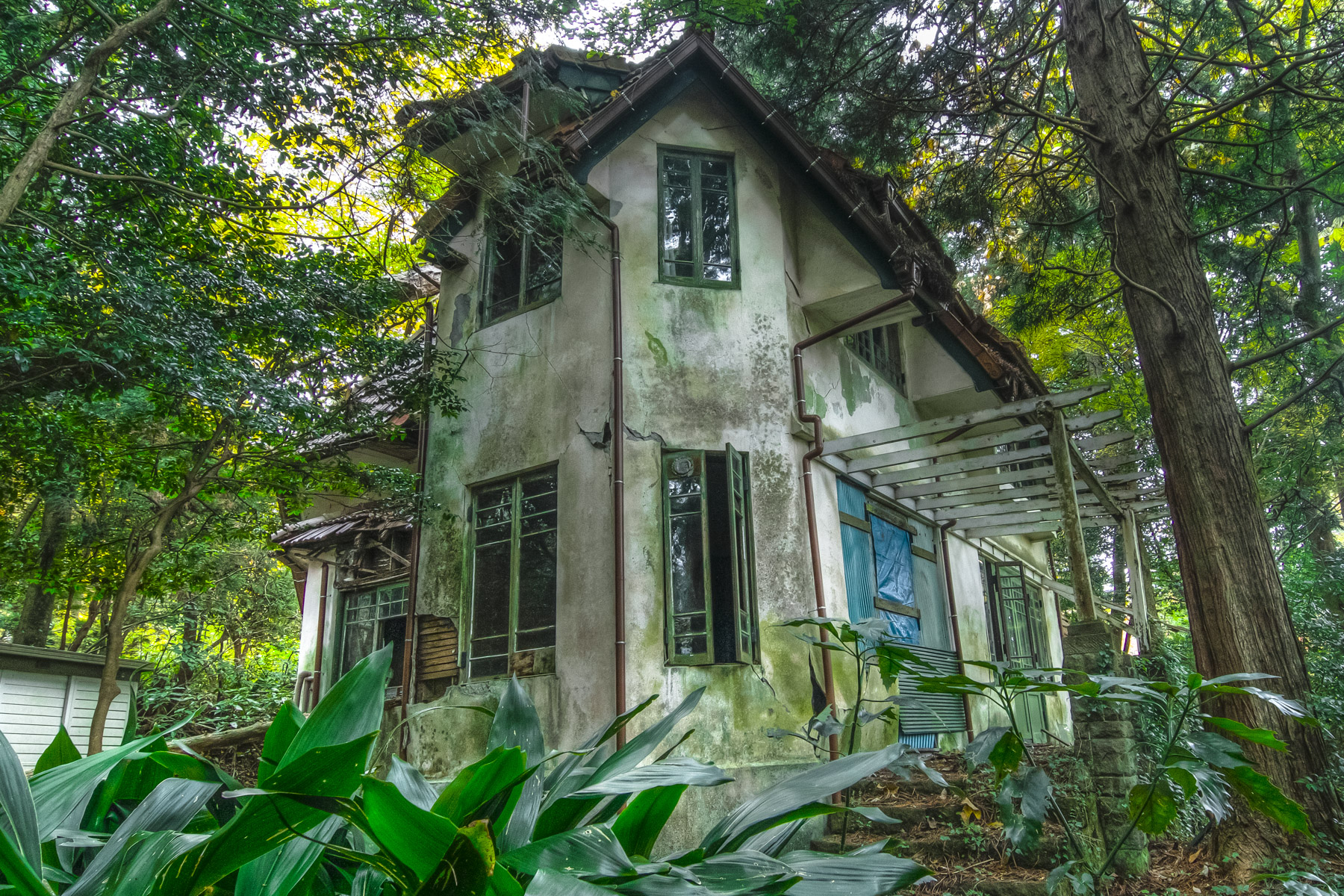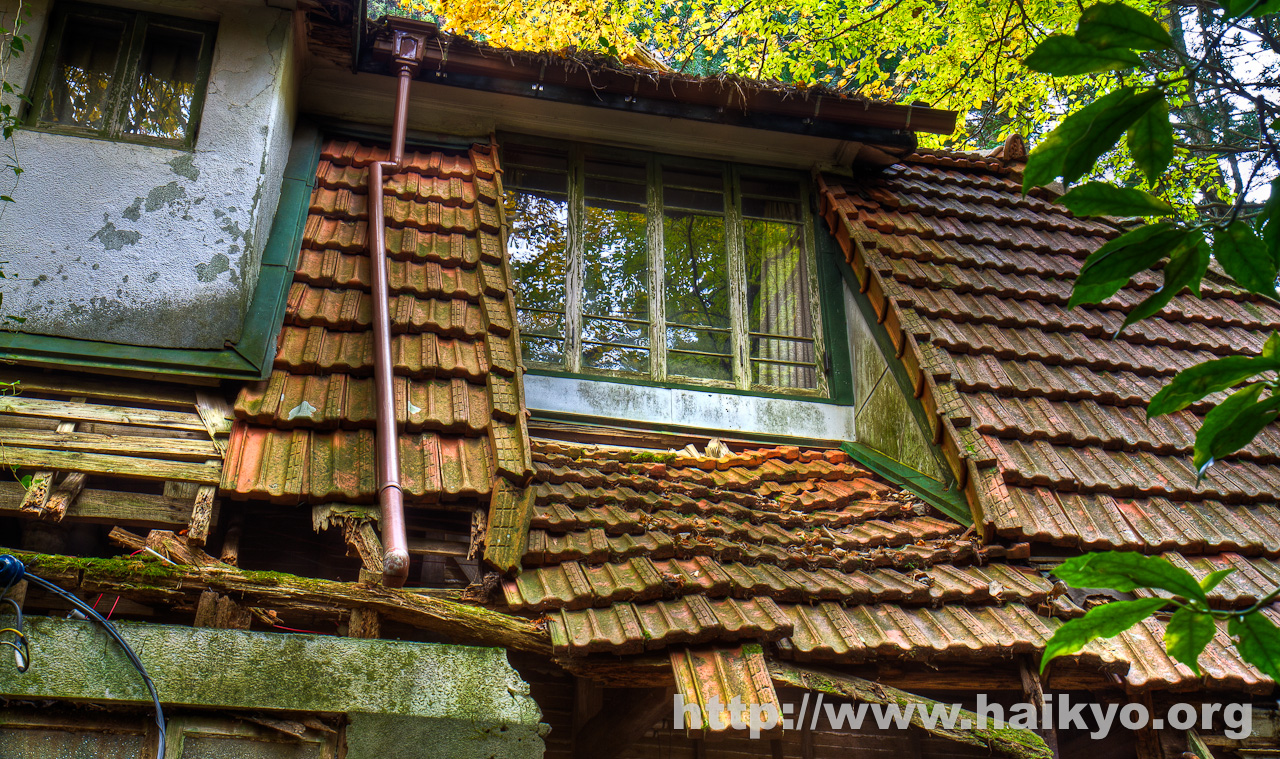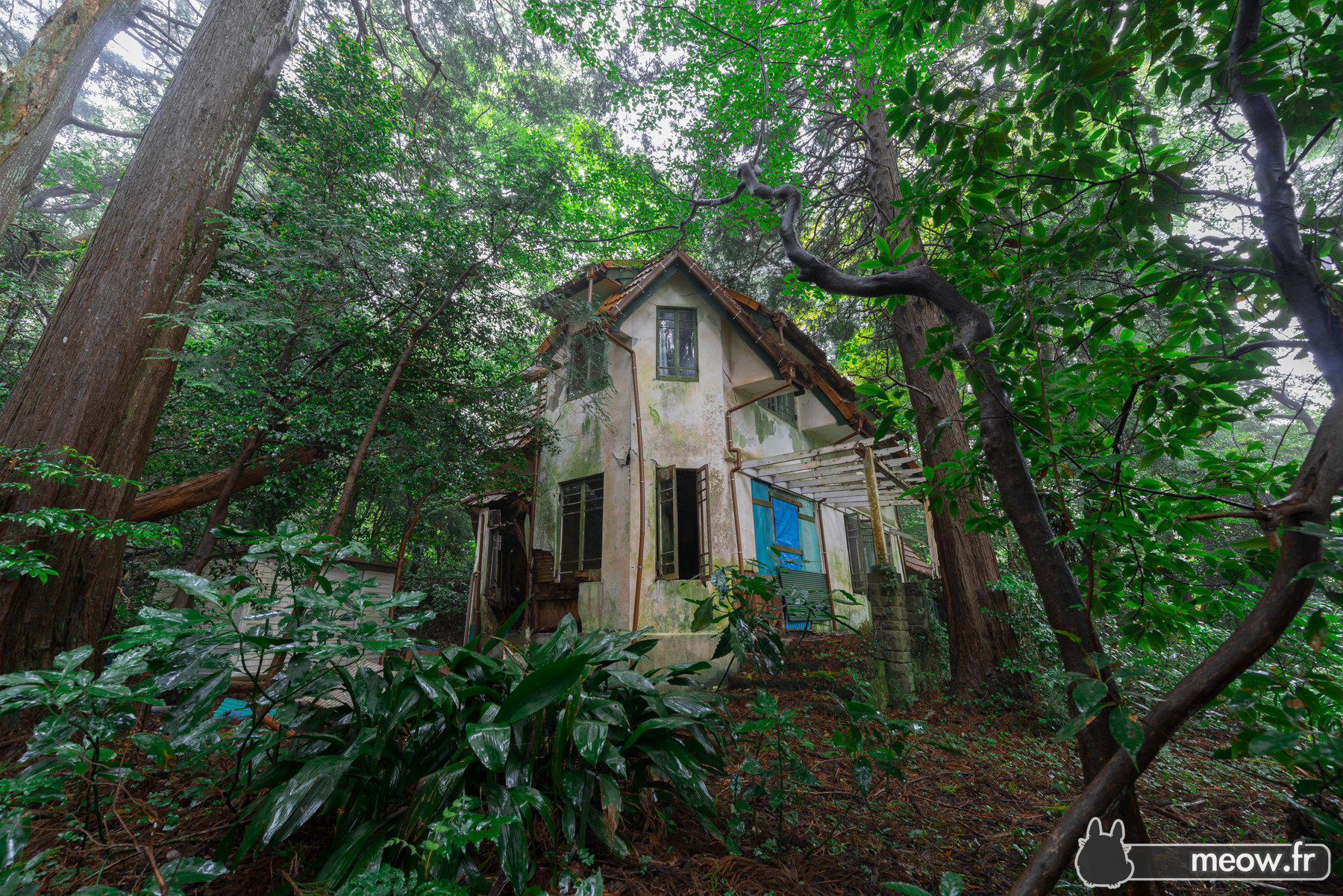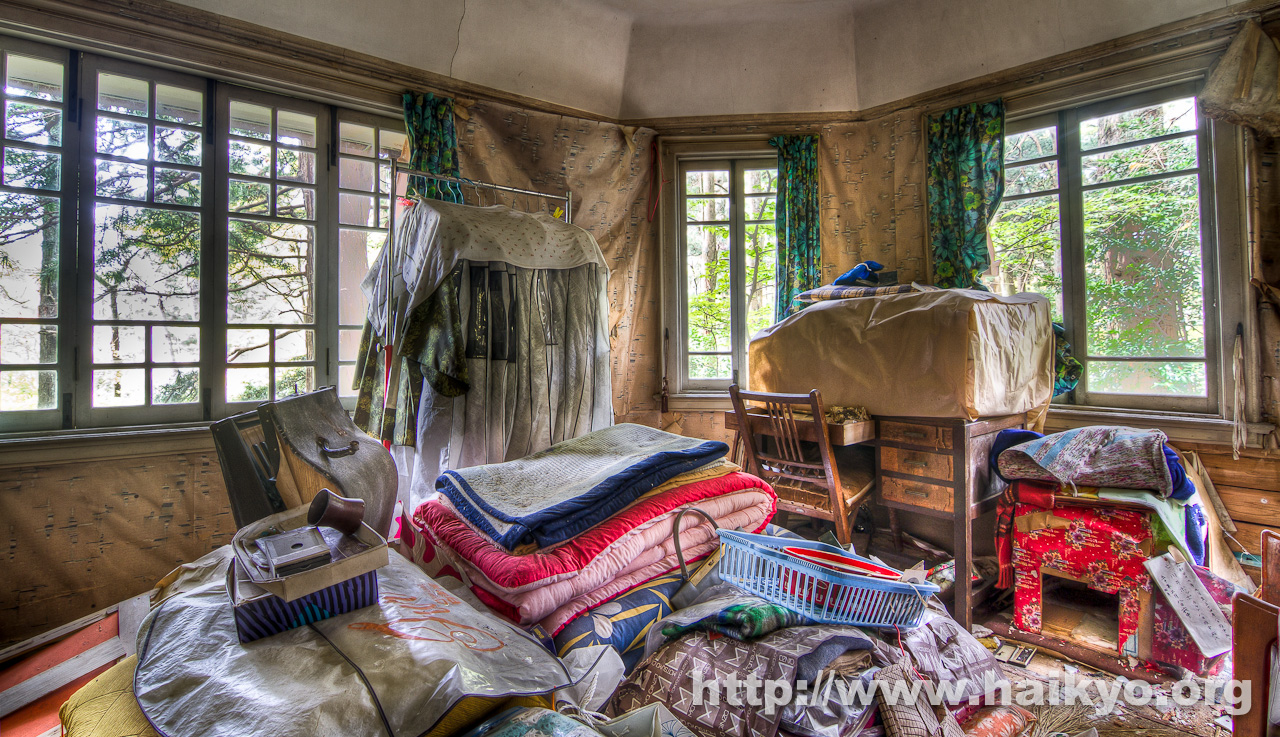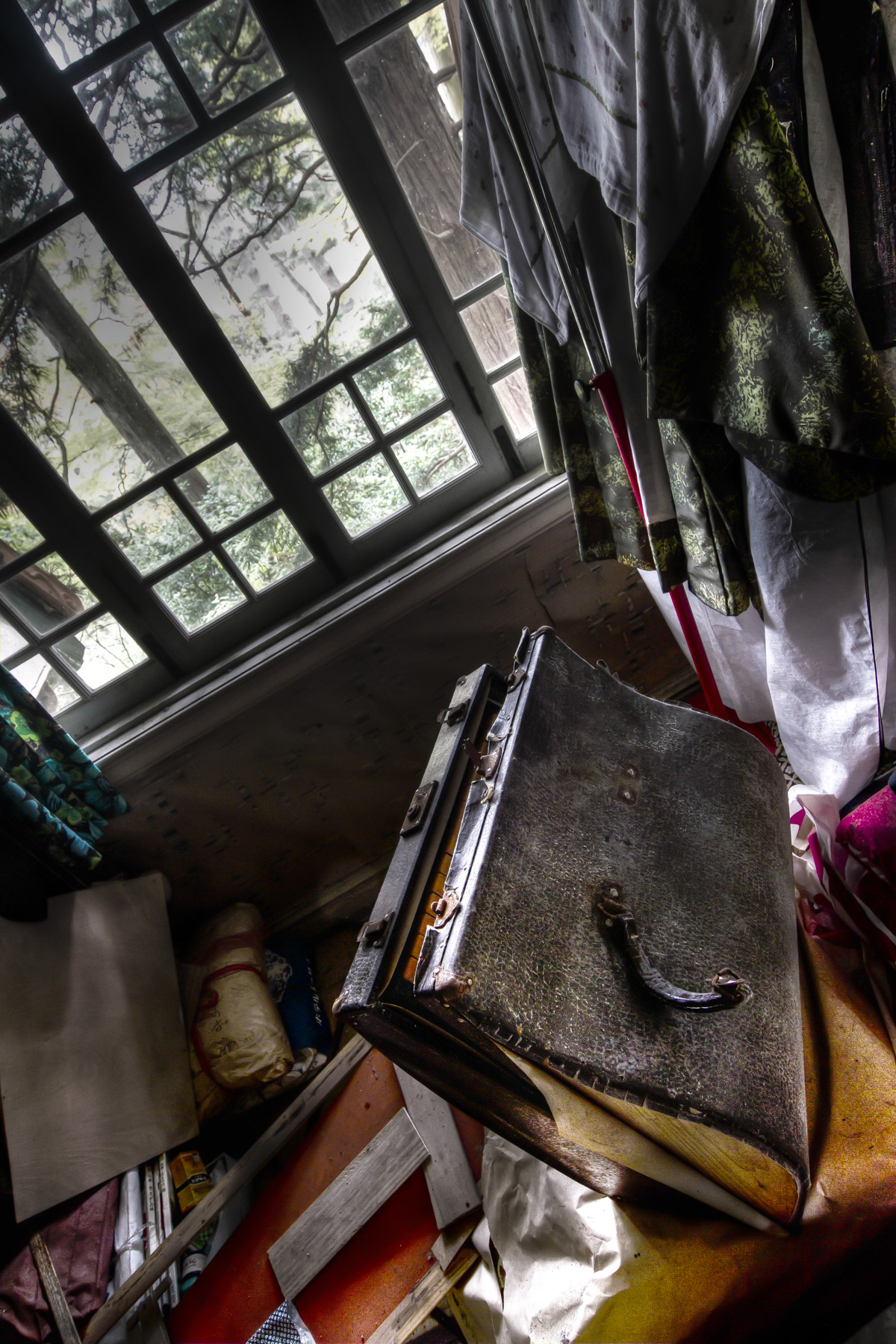In the middle of the luxurious woods of Kanagawa, we felt like Hansel and Gretel when we discovered this abandoned house. This one is not made of gingerbread however. But maybe we will discover an old witch and her stupendous stories? Here is the Royal House, one of the most famous haikyo in Japan. It’s known in Japanese as Karei Naru Ichizoku (A Majestic Family). Its location has been kept very secret for years to protect the precious artifacts it hosts.
Many trees fell on the house, destroying windows and a part of the roof. Since then, the moisture has infiltrated everything: the wood – which makes the main structure – has become very spongy, and plaster on the outside walls is covered with mold. But in this decay, we can still guess that this house has a past rich in stories. And I know that entering this house will be like reading a story from an old book, the pages turning into dust as we are turning them.
The windows are all opened and we can access the house easily by one of them. A doll wearing a kimono welcomes us at the entrance. Yes, that is a rather traditional introduction for a haikyo! The ground floor comprises of a large dining room and a small kitchen behind it. The dining room is already an amazing discovery. Two ancient TV sets, lots of tiny antiques and a huge panda with the skull smashed. The kitchen is in a more precarious state than the rest. I tried to move a little but I sank suddenly by 50 cm. It is risky to go further. It is too bad, I would have loved to have a peek into the refrigerator. There could have been perhaps food, expiration dates and signs of a past life? I could just spot a third TV set there: the first in the range of Sony Trinitron, the KV-1310, a model dating from 1968.
We climb the stairs. The floor is fortunately way more stable than I thought. Up there, two more rooms, filled up with more treasures. At the entrance of the first, a picture of an old Japanese woman. Further away, same size, another photo. This one is depicting an old westerner, a cigar at his fingertips and a glass of wine in front of him. Was he living there with the lady?
I enter the first room. It looks like an office but it is difficult to see clearly. The forest around the house is so dense that, despite the three large windows, the room is still very dark. Bedding is stacked everywhere. It looks like someone had wanted to put everything away, quickly. It’s difficult to fight our curiosity and we open a few drawers to see what is inside. They are full of memories: postcards, letters, bills, old coins and notes, stocks, various objects, like in any house, but from a long time ago. But the most amazing are the photographs. They are depicting life in Tokyo and the life of this family, which seems actually pretty large. One picture strikes us more particularly: the old westerner walking with the Queen of England, having a chat! This changes the way we see this house completely and we are decided to find its story. The names of our two main characters also become clear: the foreigner was named John and his Japanese wife was Sugiko.
In the other room, there is an expensive-looking painting of a much older woman. She looks strict and severe. There is also a butsudan (a little altar found in houses to veneer the dead) so this older woman seems to have been the mother of Sugiko. She seems to have had a pigeon has a pet: there are many pictures of him walking around in the house and he even has his own little hut. He was called Po-Po-Chan. Cute?
In this room, we find another TV, a fourth one. There are photos displayed here with Hirohito and the Royal Japanese family, surrounded by other photos of the family living in this house. What are the links between all this? Another curious fact is the presence of many boxes wrapped in paper from the Okura Hotel, a renowned and luxurious hotel situated in the center of Tokyo. I also find by chance the address of John. He used to live in Tokyo. This address and the Okura Hotel could be an interesting start for my research of information.
Back in Tokyo. I first show up, a little innocently, at the reception of the Okura Hotel to check whether a certain Sugiko is still living here, knowing that it is almost impossible. Oh! This was a long time ago! I am told, after five minutes of fierce battle with the old computer. But these are private information. I don’t know what to do so I spend the afternoon exploring the hotel, talking to the old tenants of the stores and employees at the cafe. Only two clerks remember Sugiko and John. According to them, the family was extremely wealthy and they were able to afford living at the hotel. Sugiko used to go to the coffee shop nearby every morning and the staff was always a bit stressed out about it. They do not give me any clues nor links to the old house however. I decide to leave for the next destination: The old address. Unfortunately there is absolutely nothing there, the land has been leveled. There must be another way.
I go back to the abandoned house to see if I can find more information with the help of a Japanese friend. Indeed, she finds almost immediately a photo depicting a temple with a sotoba (plank of wood with the family names written on it found at the tombstones) showing clearly the family name. The name of the temple is also mentioned and it is in Tokyo. That is my next destination.
The temple is really small and the family who owns the temple is located nearby. I try my best to look like a foreign journalist and knock at the door. Within seconds, an old man opens the door. He knew the family, although he does not remember very clearly, he provides some interesting details such as names, events and dates. Then he opens his register and shows me a page entirely dedicated to the family. The information, scribbled, is not very comprehensive but there are many facts that combined together give sense to their story.
I feel like I have entered the last stronghold of post-mortem information about this family. I even get the chance to visit the actual tomb, it is a bit further away. John and Sugiko are on the same sotoba – wooden board where the Buddhists register a kind of prayer accompanied by the name of the deceased. There is no one left alive and they have no offspring. Since it is rarely visited and maintained, it was moved to another field. I feel deeply moved and I attempt a little prayer for them.
In 1936, the young John met Junji, the brother of Sugiko, in Paris. Junji was a diplomat working for the Japanese government. Their encounter was somehow linked to the fact that John would receive his uncle’s pearl business and expand it to Japan. This family pearl business was already very important and was located at the Hatton Garden in London. John definitely met Sugiko at that time. In one photo I found, she was also in London at this time and she was extremely pretty. The business affair turned also into a love story. World War II started, however, and John had to join the fight. He won a few battles against the Nazis and was even rewarded with the Royal Cross for delivering a village. Then he moved to Japan, for business and love.
The house was built in 1948 and he got married with Sugiko in 1950. They actually did not live there: the house was for Sugiko’s mother, Junji and Kiyomi, another sister. The three of them seemed to have received a lot of presents and donations from John and Sugiko throughout their life. John, extremely wealthy, established a foundation in his name in 1977 called The Jerwood Foundation. He made a lot of generous donations, thus explaining the existence of this photo where John is present alongside Queen Elizabeth. The Foundation is particularly active today but sadly does not have much information about his founder.
John got really busy and Sugiko moved to the Okura Hotel. Kiyomi, meanwhile was alone at the Royal House since everyone else has passed away. She quickly joined Sugiko to enjoy the hotel life together. Ten more years went by. The Royal House got dusty and almost forgotten. There are proof that the family visited it however. I found Kodak VR CP-100 negatives (sold between 1983 and 1986) depicting Kiyomi visiting the house.
John died in 1991 in New York of a heart attack. Sugiko stayed at the hotel until 1997 and died at the age of 78. Kiyomi stayed until 2004 and died at the age of 91 years old. The Okura Hotel then sent all their belongings in boxes back to the Royal House. Those boxes were just put at the entrance of the house by Yamato, a famous delivery company in Japan.
But this is not the end yet. In this story full of old memories and ghosts there still somebody alive: the younger sister. She is called Kiyoko. At the temple I learnt that she got married and now belong to another family. Because of that, the temple has no link with Kiyoko anymore and there is no more information about her. But am sure that, sometimes, she comes here and visits the old tomb of her former family. I walk around the temple, hoping to find an old lady that might look like her. The sun sets and home calls me back. I still hope to see her someday.
TIMELINE
1902. Torinosuke birth (1902/03/03)
1912. Kiyomi birth (1912/03/25)
1918. John birth
1919. Sugiko birth (1919/08/31)
1935: John enters his uncle pearl business
1936. John meets Junji
1937. Postcard from Ichiro Hatoyama to ?
1942. Sugiko Photograph took by K. ITOH (1942-9-2)
1943. John operation in the village of Arielli (29 DEC)
1944. John gets the Military Cross
1947. John demobilized + goes to Japan + take over his uncle business
1948. House is built (John is 30)
1949: Bank Account of Junji
1950. John (32y) marries Sugiko (31y)
1951: Admiral Radio/Phonograph 6S12
1956: Happy-Chan birth
1960. Postcard from Sugiko (41y old) to her mother (from London to the house)
1962. TV Sony Trinitron
1962: Okura Hotel opens
1965: Kuma death
1970: Happy-Chan death
1972. Po-Po-Chan (the pigeon) birth (September)
1973: Donation to the temple (in which they are buried)
1975. Message on the wall from John (impossible to read)
1977. The Foundation is established
1979. Po-Po-Chan death
1982. Calendar in the house (seen on a picture)
1982. Junji death (source: 2ch)
1983. Metro Map
198x. Pictures of the inside taken with a Kodacolor VR-100 CP film (sold between 1982 – 1986)
1989. Calendar in the house (seen in the house)
1991. John (73y) death (heart-attack in New York)
1992. Thank you Postcard to Sugiko and Kiyomi from Yuuichiro
1995. Okura Laundry Notes (Sugiko and Kiyomi)
1996. Happy Birthday Postcard (1996/03/25)
1997. Sugiko death at 78 years old (2004/11/19)
2004. Kiyomi death at 91 years old (2003/11/22)
THANKS
Thanks to Miu-Miu, Matsu, Sato and Sachia for helping me gathering the pieces of the story. This adventure is also shared with Gakuranman, and we learned a lot by visiting the place together and exchanging our information.
FACTS
- 1948-1989

